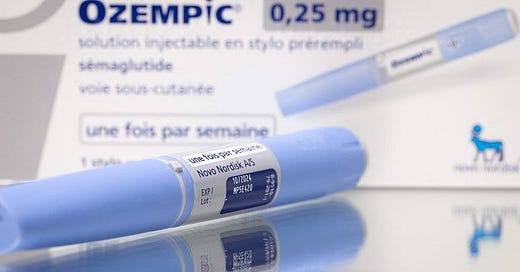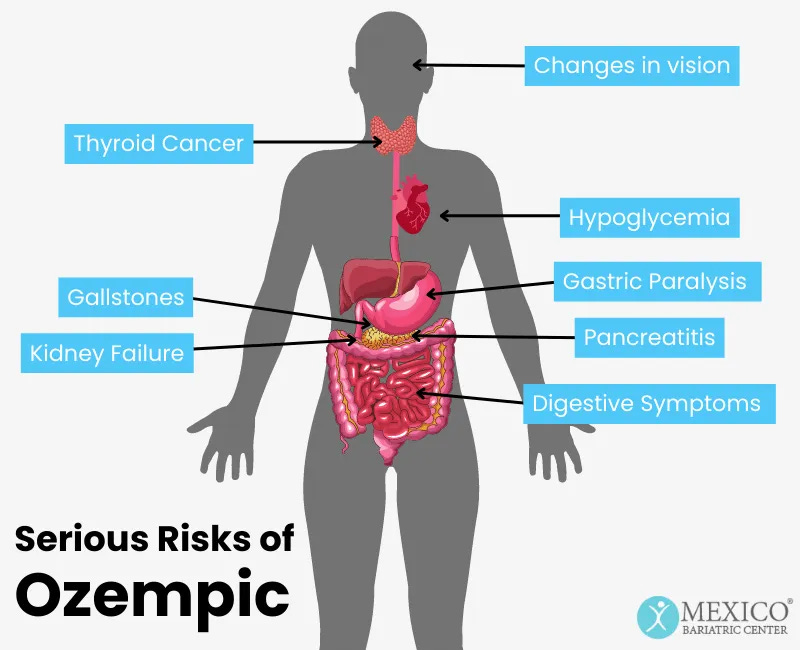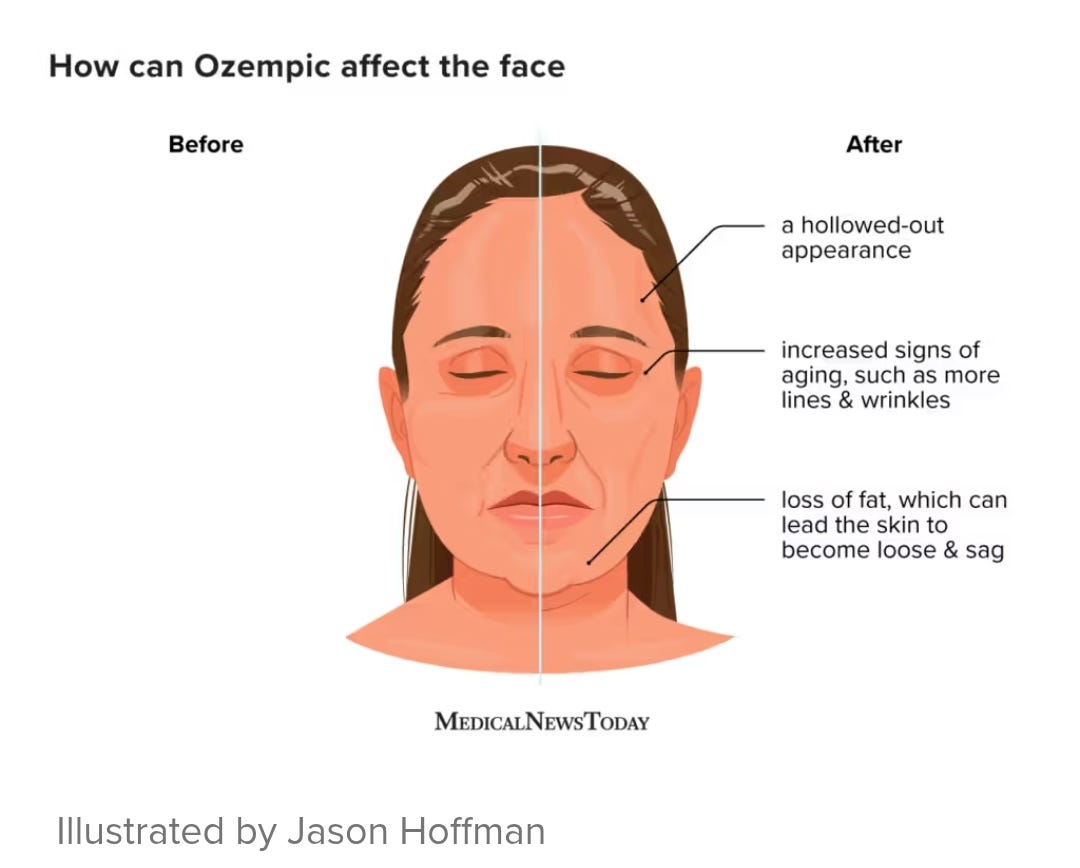The Dangers of GLP-1RA Weightloss Medications
This breakdown will delve into the very real dangers of using GLP-1RA weightloss drugs such as Ozempic or Wegovy, and why you should stick with traditional weight loss methods.
Ozempic/Wegovy is being used en masse by people from all walks of life as a quick, easy way to lose weight without having to put in any of the usual hardwork, diligence, exercise, and willpower that you’d normally do to lose weight. Unfortunately, it comes with widespread, and potentially fatal, repercussions that many folks seem to be utterly unaware of, and I’m going to dive into these dangers in this breakdown.
My heart goes out to Sharon Osbourne and all others suffering from horrific adverse side effects of using Ozempic/Wegovy and other GLP-1RAs; all because they listened to their doctors, who were either ignorant or money-hungry in prescribing them these scientifically altered imitation peptides for weight loss.
The peptide used to make these drugs, the GLP-1 (glucagon-like peptide-1), is a naturally occurring gut peptide hormone that plays a key role in regulating appetite and food intake by promoting feelings of satiation [i.e., fullness and reducing hunger]. This ultimately can contribute to weight loss, achieving this by influencing the brain's control of appetite and by drastically slowing down the body's rate of gastric emptying.
Naturally occurring GLP-1 peptides are released upon food consumption, creating satiety lasting around 15 minutes. The drugs containing the GLP-1 receptor agonist like Ozempic/Wegovy, however, are made to increase satiety to make it last up to two days!
GLP-1RA medications stay in your system for about five weeks, though the effectiveness wears off before then. As effects gradually taper off as more of the medication is eliminated, most people start to experience food cravings and hunger a week after their last injection, making it so you'll only maintain your weight loss if you keep taking the drugs.
Then, on top of being artificially full-feeling for extended periods of time. Gastroparesis then causes the digestive system to slow to an almost standstill, creating bezoars, hardened stonelike masses in the digestive tract, that build up in the stomachs of Ozempic/Wegovy users, because of foods staying in the digestive tract for much longer than they're meant to be. In a recent study, they found 4 of 23 bariatric patients receiving GLP-1RA “therapy” had bezoars, while 0 of 77 patients not receiving said therapy had bezoars.
Symptoms of gastroparesis-induced bezoars can include nausea, vomiting, abdominal pain, bloating, feeling full quickly, and ultimately an utter loss of appetite. In severe cases, bezoars can even cause blockages that prevent food from moving to the small intestine, leading to an inability to have bowel movements, potentially becoming life-threatening!
Interestingly enough, and not to mention, a show of how bad Coke is for your insides—a commonly doctor-prescribed bezoar treatment is 3 liters of Coca-Cola every 12 hours to dissolve or fragment the bezoar so it can be passed!
Ozempic/Wegovy has been associated with several other potential dangers and serious side effects. It may cause thyroid tumors, including thyroid cancer, and individuals with a personal or family history of medullary thyroid carcinoma (MTC) or multiple endocrine neoplasia syndrome type 2 (MEN 2) should not use the drug.
Additionally, Ozempic may lead to pancreatitis, which can be severe and requires immediate medical attention if symptoms such as persistent abdominal pain occur. There is also a risk of low blood sugar (hypoglycemia), especially when used in combination with other medications like sulfonylureas or insulin. Long-term side effects may include vision problems, acute kidney injury, and acute gallbladder disease, with some effects potentially lasting months or years after discontinuation.
Semaglutide, the GLP-1 receptor agonist used in Ozempic/Wegovy, can also potentially affect one's moods, with some individuals experiencing mood changes, worsening of existing mood disorders, and even suicidal ideation [as has been reported to the FDA].
Aside from the aforementioned potentially fatal, and, at the very least, extremely unpleasant issues; the weight lost through the use of Ozempic/Wegovy is not just fat loss! Up to 60% of the weight lost is lean muscle mass and bone density! Up to 13.9% loss of lean muscle mass, even including losing heart muscle, can occur with these drugs. Since your body thinks it's starving, it takes to the extreme measures of eating itself to survive, including your muscle and bone—just like you'd see in the skeletal, gaunt survivors of concentration camps in the Holocaust.
The so-called "Ozempic face" you see, the gaunt, sunken-in, saggy faces of Ozempic/Wegovy [GLP-1RA] users, is a result of the indiscriminate, ultra-rapid weight loss, causing facial fat to melt away, altering the structure and volume of the face.
The shocking part is that no one seems to know about any of these detrimental adverse effects of Ozempic/Wegovy [and other GLP-1RAs] use, and just want to take the shortcut, fast-track to rapid weight loss without doing any independent research outside of the information you may or may not be told by your prescribing physician!
Unfortunately, many physicians may even receive monetary kickbacks for prescribing these drugs to as many patients as possible, and may convince their patients that they need to use these drugs to lose weight and that there are no potential dangers to using these GLP-1 receptor agonists [which is obviously very wrong].
There are ways to stimulate GLP-1 naturally, such as, focusing on consuming a diet rich in fiber, healthy fats, and protein, while incorporating certain herbs and supplements into your diet as well. Specifically, prioritizing foods like whole grains, fruits, vegetables, lean protein, nuts, healthy oils, and certain herbs like berberine, curcumin, and resveratrol may also help in naturally boosting your body’s GLP-1 levels.
For a look into how I lost 100lbs in a year, check out my weight loss article on my old website, Fiery, but Mostly Peaceful Sara!













